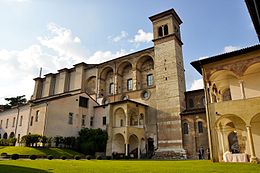San Salvatore Abbey (Brescia)
San Salvatore (or Santa Giulia ) is a former monastery in Brescia in Lombardy that is now used as a museum. The monastic complex is known for its architectural diversity, which includes buildings from Roman, pre- Roman and Roman times as well as the Renaissance . In 2011, San Salvatore was under the name of Power (568-774 n. Chr.) The Lombards in Italy, places in the World Heritage Site added. According to tradition, San Salvatore is the place where Desiderata , the daughter of the Longobard king Desiderius and wife of Charlemagne after the dissolution of marriage in 771, lived.
history
San Salvatore was founded in 753 by Desiderius, later king of the Lombards, and his wife Ansa as a women's monastery. Their daughter Anselperga became the first abbess. Despite the Lombards' defeat by Charlemagne, San Salvatore retained its privileges as a royal monastery and was even able to expand its possessions.
From the middle of the 9th century, San Salvatore was one of the abbeys that served to supply members of the Carolingian rulers of Italy:
- Gisla, † 860, 851/860 Abbess of San Salvatore, daughter of Emperor Lothar I.
- Gisla, † before April 28, 868, 861 Abbess of San Salvatore, daughter of Emperor Ludwig II.
- Engelberga , † 890/891, 868 Abbess of San Salvatore, wife of Emperor Ludwig II.
- Ermengarde , † 896, 878 Abbess of San Salvatore, daughter of Emperor Ludwig II, wife of Boso von Vienne , mother of Emperor Ludwig III.
In the 12th century, most of the buildings in the Romanesque style were restored or rebuilt, as well as the oratory of Santa Maria in Solario . In the 15th century, all parts of the complex were restored and a dormitory was added. In 1599 the church of Santa Giulia was completed.
The abbey was dissolved in 1798 after the French occupation of Lombardy. The buildings were used as barracks and then left to decay. In 1882 the complex became a museum for the Christian era. However, the decay could not be ended until 1956 with the last restoration work. In 1998 the Museo di Santa Giulia was added.
architecture
San Salvatore Abbey includes:
- The Chiesa di San Salvatore , a basilica from around the 9th century with a nave and two aisles; it was built over an older church, which consisted of a nave and three aisles; this in turn was built on a Roman building from the 1st century BC that was destroyed in the 5th century. In the bell tower from the 13th-14th centuries There are frescoes by Girolamo Romanino in the 16th century . Inside the church there are frescoes by Paolo da Cailina the Younger, alongside frescoes from the Carolingian era. The presbytery, reserved for nuns, was built in the 16th century and was previously the nuns' choir dating from 1466 .
- The Chiesa di Santa Maria in Solario was built around 1150–80. It is a two-story chapel on a rectangular floor plan with an octagonal lantern on the roof and a small loggia on the outside. Inside it was decorated with frescoes by Floriano Ferramola in the Renaissance period (1518-20), which contain mariological themes in the upper part, scenes from the life of Jesus.
- The Chiesa di Santa Giulia dates back to the 16th century
- The museum with finds from the Bronze Age to Roman times, including the famous Winged Victoria . In the medieval section there is a crucifix that Desiderius is said to have owned. Furthermore, fragments of today destroyed architecture of Brescia are exhibited, for example frescoes from the Broletto , a statue of Faustina and a fresco cycle by Alessandro Moretto .
- House foundations from Roman times were excavated on a meadow with orchards reserved for the nuns .
literature
- Renata Stradiotti (ed.), San Salvatore - Santa Giulia a Brescia. Il monastero nella storia (2001)
Web links
- Basilica of San Salvatore on the sides of the city of Brescia (ital.)
Coordinates: 45 ° 32 ′ 23.5 ″ N , 10 ° 13 ′ 41.3 ″ E




